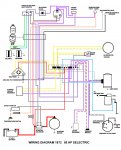I think you know enough that I probably don't have to write a book. You have about 12V to the amplifier, so let's assume everything is ok up to that point. Next thing is to decide whether the amplifier or coil is at fault, or is the spark getting lost in the distributor cap. Disconnect the blue wire, then unbolt the coil and unscrew the spark wire from the dist cap. Reinstall the coil and rig up a spark gap from the end of the disconnected spark wire. Disconnect the black/white striped wire. Turn the key on. Now lightly brush the striped wire across an unpainted grounded item. You should get a flurry of sparks across the gap at the end of the spark wire. If you do, the amplifier and coil are capable of doing at least something, and the trouble most likely is under the flywheel.
As for the blue wire, that would be very fast DC pulses. The original method of checking was with a now obsolete neon tester. Now the preferred method is with a DVA meter (peak reading voltmeter). The pulses are way to fast for a regular meter to respond and produce a reading. A peak reading meter detects the pulses and stores the result long enough for you to get a reading. To tell the truth, I don't even know what the reading should be--somewhere around 300V I think. In any case, you should not be trying it with the blue wire disconnected. Possible amplifier damage could occur.
In fact, that system is very touchy concerning loose connections, especially in the battery, battery cables and connections and alternator wiring. High voltage spikes from loose or arcing connections spell death to the amplifier.
Briefly, how it works, is 12V is supplied to the amplifier, and the amplifier increases it to about 300V and stores it in a capacitor until time to fire a plug. The breaker points making and breaking a ground on the striped wire are what tells it to fire, each time the ground contact is broken. When the ground contact is broken, the 300V stored in the capacitor is discharged through the primary winding of the coil, and the coil increases that 300V to whatever it takes to fire the plug. The distributor does just what a car distributor does, point the spark to the proper plug wire. I might add that the distributor is a POS in my not so humble opinion. The anti-reverse cutout ring grounds out the points wire if the engine tries to run backwards. Yes, it can run backwards. The ring should be lubricated very sparingly with HT grease where it rides on the crankshaft. Breaker points should be gapped at .009" to .010". Very critical.
Coil primary and secondary windings can be tested for continuity/resistance with an Ohm meter. But again, I don't remember what the expected resistance readings should be.
Hope this helps at least a little bit.
EDIT: That should be "EP" (extreme pressure) grease on the cut-out ring.




















